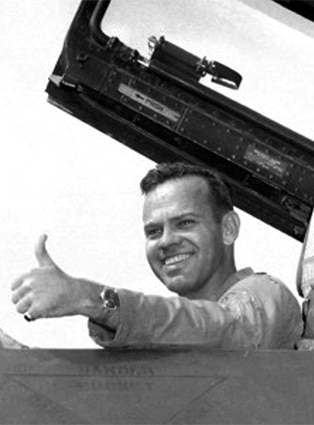“After F-84Fs at Luke, we went to Nellis for F-100 school. This was November of 1957. We got a week of ground school to learn the aircraft systems then to the flight line for checkout. They had a couple “F “ models so we got a ride in the “F “ with an instructor prior to the first flight in the “A”.
Nellis was Mecca for an aspiring fighter pilot. It was home of the famed Thunderbird flight demonstration team. When you got to Nellis you had arrived. At Nellis, we were to fly the F 100, the first airplane that would go supersonic straight and level. We flew the “A” model, which was a real hot Rod. It had inboard ailerons, no flaps and no wing stations for mounting external stores so the only thing we could do with the airplane was panel strafe, air-to-air gunnery, and air combat maneuvering.
Our in-briefing was a little more relaxed than the one we got at Luke and also a little bit strange. The briefer told us that they knew what we were going to do in our spare time. They said we would go out on the strip in Las Vegas and quickly lose all of our money so they had arranged things with finance so that we could get our $4.50 per diem every day. I thought, surely they were joking at the time, but they weren’t and sure enough within a week and a half I was over at finance every day getting my $4.50. Life was good at Nellis, we had a two-week engineering course to learn the operating systems of the F100 and then we started flying. We got one ride in the F model an F100 with two seats and the next ride was solo in the F100 A.
When I took off in the “A” I climbed up to about 10,000 feet did a few rolls and then attempted a loop. At the top of the loop, I got a compressor stall. When you get a compressor stall in an F100 fire shoots out of both ends of the airplane and you hear a large bang-bang-bang-bang-bang which bounces your feet off of the floor of the airplane. It is caused by insufficient airflow coming into the intake to maintain the proper airflow through the engine so the compressor blades stall out. All you have to do to stop it is lower the nose and get some air flowing through the engine again and it quits. It is quite alarming the first time it happens to you, however, but fortunately, we had been briefed on this before our first flight so I knew what to do.
After I recovered from my compressor stall I flew through the Grand Canyon and then climbed up to altitude and punch through the sound barrier. Chuck Yeager had nothing on me.
We all got Mach buster pins to wear on our lapels and a plastic model of the F-100. I gave mine to my dad.”
(From his book: This is my Life, by Roger Williamson. For a copy of the book, please email Roger directly at willyfp@icloud.com)







